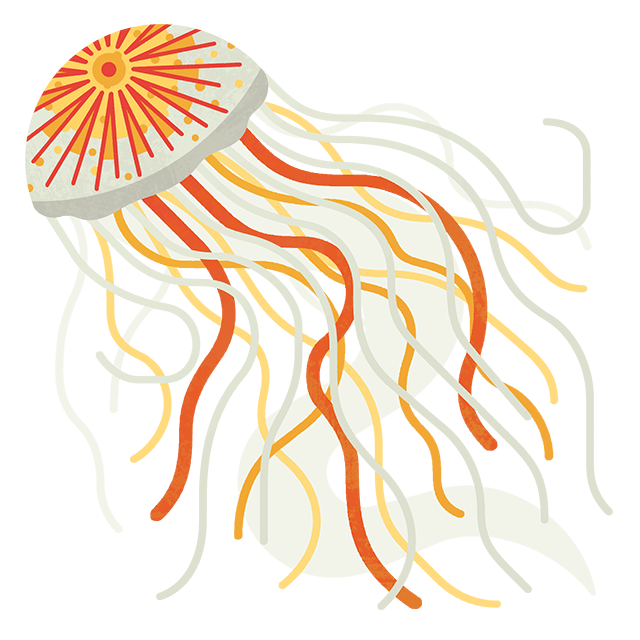
Jellyfish: Helpful hero, not stinging villain
Jellyfish often get bad press for their stinging sensibilities. But they’re actually remarkable creatures which not only benefit our seas, but the wider environment, too.
From helping to transfer carbon, to providing food and shelter for other fish and controlling fish populations – there’s so much more to jellyfish than their sting.

Credit: Peter Bardsley
Carbon transfer
Jellyfish play an important role in the carbon cycle, which in turn assists in climate regulation.
Jellyfish feed on phytoplankton, which are responsible for most of the transfer of carbon dioxide from the atmosphere to the ocean. When they feed on plankton, jellyfish consume carbon, and become a source, or 'sink', of carbon.
Carbon is transferred from the ocean's surface to the seabed as jellyfish consume plankton, carbon is cycled to the seabed by jellyfish faeces or when their remains sink to the ocean floor.
Collections of jellyfish remains on the seabed are called ‘jellyfish falls’ and it’s estimated that one of these falls could deposit four times the amount of carbon that’s input to the sea annually.
Fish populations and biodiversity
By preying on fish which have an abundant population, jellyfish help to control fish stocks. Controlling these fish populations frees up some of the ocean’s resources, which can be used by less well-established fish species. This allows these fish species to grow and thrive, helping to enhance ocean biodiversity.
In the 1980s, jellyfish played an important role in pest regulation – although the pest was another species of jellyfish!
When an invasive species of jellyfish called Mnemiopsis entered the Black Sea and preyed on fish, it had a devastating impact on the fish populations and the Turkish fishing industry. But jellyfish later came to the rescue, when the Bereo species was introduced to the waters. Bereo prey on Mnemiopsis and almost nothing else – this meant the number of invasive jellies decreased, the number of fish increased once again, and the ecosystem was able to recover.
Providing habitats and food
Jellyfish can provide food and shelter for other marine organisms. Because of their large size and slow swimming, developing fish can shelter underneath jellyfish as they drift through the sea. Other organisms can also feed off any prey they find either on the jellyfish, or that they encounter as they travel through the sea under them.
Jellyfish also act as a food source for a variety of different animals, with hundreds including them in their diets.

Credit: Mark Kirkland
Nutrient cycling
As they move through the sea, jellyfish displace water which helps with oceanic mixing. By swimming between different layers of water, they help to transport nutrients and other matter through the sea. These nutrients can be recycled and used by various marine organisms, before being released back into the ocean, where the cycle repeats.
Jellyfish release products such as mucus and faeces into the sea which bacteria use for respiration. This helps to cycle carbon between jellyfish, bacteria, and other marine organisms. It's estimated that between 3.7-6.8 billion tonnes of organic carbon can be traced back to jellies each year - a similar amount to the USA's annual carbon emissions.

Credit: Mark Kirkland
Food and medical use
Although not typically eaten in the UK, jellyfish is a traditional food in many Asian countries and is considered to be a delicacy. Jellyfish is usually dehydrated using alum and salt, and can be eaten in a variety of dishes.
Consuming jellyfish is thought to have some health benefits. It’s a source of protein, antioxidants, collagen, and minerals, and is also used to help treat medical conditions like arthritis, hypertension, fatigue and back pain.
Cultural
Jellyfish provide people with entertainment. They’re amazing creatures to watch, and many enjoy the relaxing, beautiful nature of jellyfish flowing through water at displays in zoos and aquariums.
Places like Jellyfish Lake in Palau - which has become one of the most popular snorkelling sites in the Pacific - rely on jellyfish to attract tourists, as people come from far and wide to see large populations in the water.
Recruiting volunteers to count jellyfish at beaches is a great way to encourage members of the public to take part and contribute to science. In 2021, over 1,500 jellyfish sightings were reported around the coast in the UK, providing us with important data to help understand where leatherback turtles might be feeding.
You can report your jellyfish sightings here and check out our ID guide to help you identify which species it is.
As you can see, jellyfish are fascinating creatures which provide a whole host of benefits to marine life, the wider environment and to us, too. They should be recognised for the helpful heroes that they are, not the stinging villains they’re made out to be.



